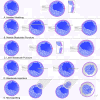Factors affecting the outcome of human blastocyst vitrification
- PMID: 19758458
- PMCID: PMC2757025
- DOI: 10.1186/1477-7827-7-99
Factors affecting the outcome of human blastocyst vitrification
Abstract
With single blastocyst transfer practice becoming more common in ART, there is a greater demand for a convenient and reliable cryostorage of surplus blastocysts. Vitrification has emerged in the last decade as an alternative promising substitute for slow freezing. Blastocysts represent a unique challenge in cryostorage due to their size, multicellular structure and presence of blastocoele. The continuous acquisition of experience and introduction of many different technological developments has led to the improvement of vitrification as a technology and improved the results of its application in blastocyst cryostorage. The current information concerning safety and efficacy of the vitrification of blastocysts will be reviewed along with the variables that can impact the outcome of the procedure.
Figures

References
-
- Sunde A. Significant reduction of twins with single embryo transfer in IVF. Reprod Biomed Online. 2007;15:28–34. - PubMed
-
- Cutting R, Morroll D, Roberts SA, Pickering S, Rutherford A. Elective Single Embryo Transfer: Guidelines for Practice British Fertility Society and Association of Clinical Embryologists. Hum Fertil (Camb) 2008. pp. 1–16. - PubMed
-
- Menezo Y, Nicollet B, Herbaut N, Andre D. Freezing cocultured human blastocysts. Fertil Steril. 1992;58:977–980. - PubMed
Publication types
MeSH terms
LinkOut - more resources
Full Text Sources

